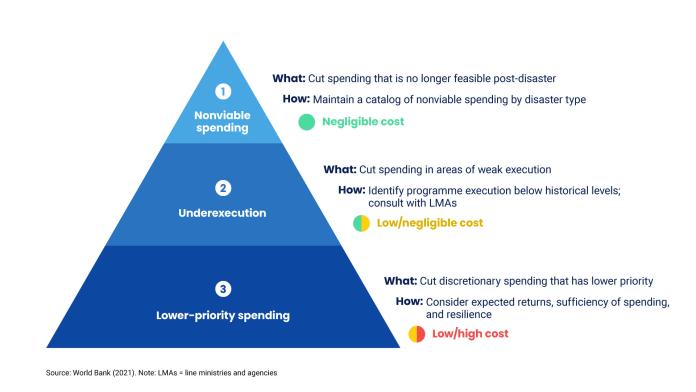A hidden cost of Covid: the opportunity cost of budget reallocations
How can decisions of fund reallocation be made more strategic to minimise the impact?
-
Date
March 2023
-
Areas of expertiseClimate, Energy, and Nature , Education , Governance , Health
-
KeywordsClimate policy and finance , Disaster risk , Climate change adaptation , Shock response , Adaptive management , Capacity building , Diagnostics , Evidence use , Inequality , Policy implementation , Policy options , Research uptake , Technical assistance , Value for Money (VFM) , Education financing , Public Sector Governance (PSG) , Public Financial Management (PFM) , Accountability , Budgeting , Economic policy , Health financing (HF) , Nutrition , Child protection , Qualitative Data Collection , Social Media Listening
When a disaster strikes, governments are often forced to reallocate their budgets to free up resources for the disaster response and to make up for the drop in domestic revenues. In addition to direct costs associated with a disaster, governments must also bear the opportunity costs associated with cancelled or postponed public expenditure, foregoing potential returns.
Key takeaways:
- Budget reallocations can incur a significant opportunity cost, but their impact is not often measured and is often overlooked. We need more research on how to capture these costs.
- More can be done to limit the costs of budget reallocations, including by devising a framework for directing reallocation decisions. Critically, this can be thought through before the disaster occurs.
- We also need strategies to enable more transparency around budget reallocations, and further discussion on how to measure impact. This conversation needs to include governments, multilateral organisations and researchers.
We recently published a synthesis on the public expenditure impacts of Covid-19 in four countries (Pakistan, South Africa, Ethiopia and Albania), for the Centre for Disaster Protection, and the World Bank. Our findings are a tentative first step in exploring an opaque, but essential, practice that countries often have to undertake to finance disaster response. Here’s what we found:
Limited options
Budget reallocations are a significant and widely used mechanism to fund disaster response. Budget cuts in our study countries were equivalent to 5-7% of annual expenditure. That’s a significant proportion, especially when compared against Covid-19 spending. It is the equivalent of about 93% of Covid-19 spending in Albania, 40% in Ethiopia and Pakistan, and 18% in South Africa. It shows that we can no longer overlook the impact of reallocations in disaster response.
The scale of budget allocations depends in part on a country’s appetite for borrowing and broader fiscal constraints. Of our studies, only Albania had the ability to increase borrowing, through an earlier and larger Eurobond issuance. Contingency budgets are not always big enough to fund responses to large scale disasters, and in Albania and Ethiopia, contingency reserves were already depleted by the time the pandemic struck. Moreover, in the countries we looked at, most of the governments did not use disaster funds to finance Covid responses, either because they were sufficiently capitalised, or because they weren’t quick enough.
Official Development Assistance (ODA) was slow to materialise and was inequitably distributed. Research from the Centre for Disaster protection indicated that ODA for Covid-19 response per capita was $104 in Albania, compared with just $9 in Ethiopia.
All of this contributed to the need for budget reallocations as a mechanism for countries to respond to the crisis: other options were unavailable or unattractive.
The pattern of reallocations is not, however, uniform across countries. Whilst budget reallocations had an impact in all study countries, there wasn’t a systematic or uniform picture of where cuts were made. Different sectors were cut in different countries. For example, tourism in South Africa, irrigation in Ethiopia and Pakistan, and defence in Albania. Education had funds diverted away from it in Ethiopia, South Africa, and Albania. The scale of use depends on the availability of other instruments.
Sacrifices will need to be made
Most reallocations incur an opportunity cost. Our findings suggest that there is a natural limit to ‘non-viable’ cuts. Non-viable in this context refers to activities which couldn’t take place because of the constraints brought about by the disaster. In the case of Covid, this relates to the widespread economic and social restrictions, for example, which meant that funding for tourism or costs related to in-person training or meetings, could not proceed. Cutting these non-viable lines of the budget were “no regrets” actions, and did not incur an opportunity cost.
Most reallocations, however, do incur an opportunity cost.
While comparing reallocations across countries is challenging due to different budgeting systems and other variations, overall, the impact ranged between 0.8-2% of GDP for reallocations in the first fiscal year of the pandemic. Our research found that each dollar reallocated incurred an opportunity cost of between USD 1.2 and USD 1.6.
Speed versus transparency
Speed is the primary advantage of using budget reallocations for disaster response financing. Reallocations can be executed quickly, so can be useful for immediate response and prove a useful stopgap whilst other financing is sought or supplied. Virements are often quicker than full-scale supplementary budgets, but have more stringent restrictions (especially in terms of the amount of funding that can be reallocated in this way). Budget reallocations were especially quick for some countries. For example, in Albania, the supplementary budget process was condensed to a matter of days.
There is a trade-off between speed and transparency. Whilst reallocation rules were adhered to, the criteria for deciding which areas of the budget to cut and which to protect, were not explicit and have not been formalised in any of the countries under review.
Often the process was driven by the ministries of finance, with other ministries having a more minimal role. Criteria and decision-making on reallocations were not necessarily documented and were forgotten over time, making the mechanism even more opaque. This emphasises the need for greater consideration of budget reallocations as a financing instrument and prompts us to think about how we can approach them more proactively, and transparently.
What next…
This was a first, tentative step to explore and quantify the impact of budget reallocations during the Covid-19 crisis. There’s more to be done, but here are four learnings
- Build and plan disaster risk financing instruments to reduce reliance on budget reallocations.
- Think about the creation and use of a framework such as the one below to guide criteria for budget reallocations. Shifting this guidance to happen ahead of crises should encourage and enable governments to make choices which take potential impacts into account.

- The process can be more accountable, inclusive and transparent, especially given that decisions and processes can be forgotten. This is a challenge for governments and public sector more broadly.
- Develop the research agenda. Our methodology is a good start, but is imperfect. This methodology could and should be applied to other sectors, and we can start looking at what reallocations add to those sectors that benefit from them.
In short, our research has shown that budget reallocations are a significant disaster risk financing instrument with advantages and disadvantages in their use. The use of budget reallocations is influenced by the availability of other financing instruments, so we encourage governments and multilateral organisations to explore alternative disaster risk finance and management. However, where budget reallocations are a valuable tool, governments can seek to plan – ex–ante–budget reallocation processes (to improve transparency) and strategies (to improve efficiency). This could minimise the opportunity cost of budget reallocations when responding to disasters in the future.


